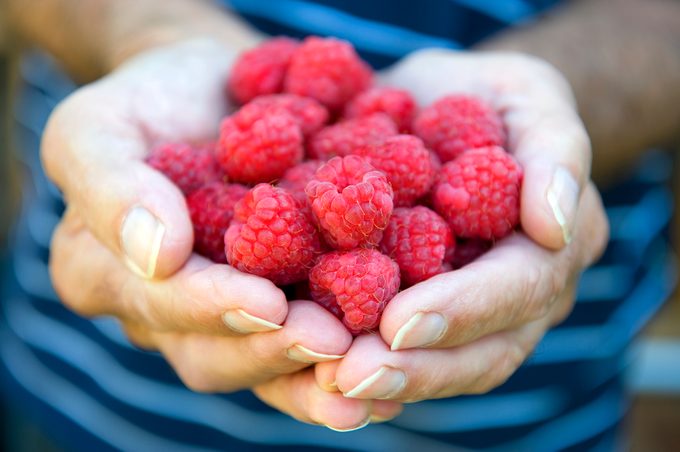

Ever try to grow red raspberries, or the less common golden variety? Both can can seem hard to do, especially because pruning instructions often seem complicated. But as I’ve heard said, “If it’s hard to do, you’re probably doing it wrong.”
Once you know how raspberries grow, and how simple they really are to prune, you confidently grow them in your own garden. Read on to learn how.
On This Page
Types of Raspberries
Raspberries are bramble-type plants that send up new shoots from the ground every year. They’re generally hardy in USDA Plant Hardiness Zones 3 to 9, and can easily form a thicket quickly if not pruned back.
There are two main types of raspberries, and many varieties within those types. If you live in one of the colder or warmer hardiness zones, be careful to choose a variety known to grow well in your climate.
Summer bearing
Summer bearing raspberries produce one crop of berries in the summer on slender woody stems, called canes, in their second year of growth. These two-year-old canes are called floricanes. ‘Nova Red‘ is an example.
Everbearing
Everbearing varieties produce two crops each season, one in summer on the two-year-old floricanes, and another in early fall on the one-year-old canes, which are called primocanes. ‘Carolina’ is an everbearing red raspberry, and ‘Kiwi Gold‘ an everbearing golden raspberry.
How To Plant Raspberries
Plant summer bearing and everbearing raspberries the same way:
- Choose a sunny location with well-drained soil. Plant in rows 18- to 24-inches wide, with room to walk down the sides of each row. Ensure the row is weed-free and add compost to the soil before planting. You may also want to test your soil to determine if you need to add any specific nutrients, because your raspberries will be growing in this location for a long time.
- Plant raspberries sold bare-root and dormant early in the spring, spacing them about two feet apart in the row. If purchasing raspberries growing in containers, plant immediately.
- Support the raspberry canes. One common way: Center a metal or wooden post at each end of the row, then attach metal or wooden crossbars to each post, with one about 2-1/2-ft. from the ground and the other 2-1/2-ft. above it. Then run a clothesline type rope from each end of the crossbar along the row to the other crossbar. The rope will support the canes.
How to Grow and Care for Raspberries

Watering
When first planted, water raspberries if you aren’t getting an inch or so of rain in a given week. Water deeply when you do. After the first year, you generally won’t need to water unless you live where irrigation is always needed, or there is a drought.
Weeding
Keep your row of raspberries weed-free, being careful not to break off canes when pulling weeds.
Fertilizing
Raspberries are generally fertilized early in the spring as they begin to grow. Stop fertilizing around July 1. Use a balanced fertilizer with equal parts of nitrogen, phosphorus and potassium. Follow the application instructions on the package.
Insect and disease prevention
To lessen the chance of plant diseases on your raspberries, purchase plants certified disease-free. Healthy plants often can sustain a little insect damage and still produce good berries.
Maintain the health of your raspberry plants by pruning out spindly growth and canes that have fruited. After a cane has fruited, it will not produce more fruit.
How To Prune Raspberries
This part confuses many gardeners. Raspberries are brambles that send out runners to form new shoots. To keep rows to a manageable width, pull out any runners growing too far out from the center of the row, roots and all. They should pull out easily and then can be cut off.
Other pruning depends on which type of raspberries you’re growing.
Pruning summer bearing varieties
- The first year, don’t prune summer bearing raspberries.
- In the second year and subsequent years, cut back any berry-producing canes down to the ground after the berries have been picked, using sharp hand pruners. Leave non-fruiting canes to grow; they’ll produce berries the second year.
- Every spring, thin out smaller, spindly canes to prevent overcrowding.
Pruning everbearing varieties
- The first year, don’t prune.
- In the second and subsequent years, cut back to the ground any cane that had berries on it in June and July after you’ve picked the berries. Leave remaining canes, which will flower and have berries on them in September.
- Every spring, cut back, by half their height, canes that fruited in September. These will have berries on them in June and July. Thin out smaller, spindly canes to prevent overcrowding.
How To Harvest Raspberries
Raspberries are ready to pick when they easily slip off the stem with a gentle tug. Wash and enjoy. They can also be kept in a refrigerator for a few days.
If you have a lot of raspberries, use them to make jam or jelly, or clean and freeze them.
